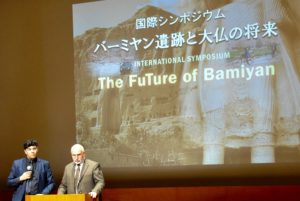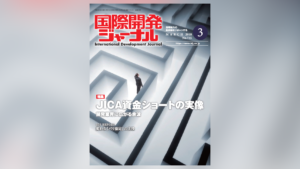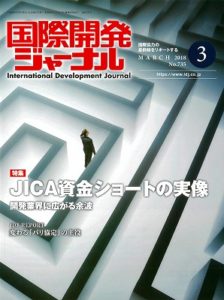Argument Continues Between Afghanistan and the International Community on Possible Rebuilding of the Bamiyan Buddha Statues
『International Development Journal』 2018 April edition
Discussion continues amongst the Afghanistan government, scholars, citizens’ groups, and the international community, on how to pass on the world heritage that is the Buddha Statues in Bamiyan to future generations. While German and Italian teams proposed a plan to rebuild the destroyed Buddha Statues, Japan has also suggested preserving them in their destroyed state in an archaeological park as an example of “negative history”. Some decision on which way to go will be decided by the summer.
First Meeting Amid Ongoing Terrorism
On February 19 this year, the initial working group meeting on the preservation of the Bamiyan Buddhas was held at the Ministry of Information and Culture in Kabul, the Afghan capital. Its members are executives of the Ministry, politicians, archaeological scholars, as well as citizens’ groups engaged in the protection of cultural heritages. They are all Afghani. Mr. Mohammad Rasul Bawary, the Acting Minister of Information and Culture, said, “We would like to create public debate on whether to rebuild the Bamiyan Buddha Statues.”
The United Nations Educational, Scientific and Cultural Organization (UNESCO) supports the working group and serves as the Secretariat. While suicide bombings continued in Afghanistan that caused delays to the meeting schedule, it was good news that the first meeting could be held.
Blown Up by the Taliban
Bamiyan is a Buddhist heritage in the Silk Road valley, approximately 230 km northwest of Kabul. There are two big east and west Buddha statues carved into a cliff in the 6th century AD, and wall paintings painted in many caves. A famous Chinese monk, Xuanzang, arrived in the 7th century and wrote in his travel book “Great Tang Records on the Western Regions” that, at the time, there was also a huge reclining Buddha. It is possible that it has been buried underground for a long time and an excavation survey may result in significant findings.
In 1971, the Japanese Emperor visited the site when he was the Crown Prince in 1971. At that time, when Afghanistan was a monarchy, Bamiyan was a popular international tourist destination.
However, the Islamic fundamentalist Taliban rejected all idols and blew up the statues in 2001. In the following year 2002, I (Yukifumi Takeuchi) accompanied the Japanese painter, Mr. Ikuo Hirayama’s visit to Bamiyan. At that time, he was a President of Tokyo University of the Arts and a UNESCO Goodwill Ambassador. He quietly sketched the Buddha statues, which were destroyed mercilessly by the Taliban, and appealed for registration and protection to the World Heritage. However, he had negative ideas regarding reconstruction of the statues and said, “It should be left, as it is, as a message for the future as a negative heritage of mankind like the Hiroshima A- Bomb Dome and the Auschwitz Concentration Camp of Nazis Germany in Poland so that such barbarianism is never repeated.” He, himself, also had a memory and thoughts as a “Hibakusha”, one of the surviving victims of the atomic bombings of Hiroshima.
Reconstruction Expectations Emerged in the Middle East
Bamiyan’s landscape and heritages were registered as a World Heritage in Danger in 2003. However, it has a strong principle of World Heritage that reconstruction is not allowed. This is because it is important to keep “authenticity” of cultural property.
However, in recent years, there has been a growing demand for exceptional rules recognizing the rebuilding of world heritage sites. It is because the destruction and looting of cultural assets by outlaws including terrorist groups of Islamic States (IS) in Iraq and Syria has become more serious. Mr. Masanori Nagaoka, a head of the cultural department of the UNESCO Kabul office, says, “If the people’s identity to their history and culture becomes stronger thanks to the reconstruction of cultural assets, and it contributes to peace-building, we would like to lay the foundations of reconstruction rules in Bamiyan.”
In 2016, the Afghan government requested the UNESCO World Heritage Committee to rebuild at least one of the two Buddha Statues.” Bamiyan Province Governor, Mr. Tahir Zuhair, said, “We, in Bamiyan, had local tourism income of 100-150 million dollars in the 1970s during the royal government period. Considering the current security situation, the number of tourists will not increase soon. However, by rebuilding of the Buddha Statues, we can expect more sustainable development. “
Japan, Germany and Italy Proposals
In autumn, 2017, an international conference on Bamiyan was held at Tokyo University of the Arts in Ueno, Tokyo, and approximately 80 people participated. The three teams of Japan, Germany and Italy proposed different preservation measures of the Bamiyan heritage.
It was Germany that started to work earlier responding the Afghan government. The German military dispatched to Afghani multinational forces brought steel frames to Bamiyan. They built a foothold and rebuilt the broken legs of the Buddha Statue on the east side in 2013. The German team was criticized by others because there was not enough coordination beforehand with UNESCO.
Germany has a history of assisting the Afghans, competing with the UK and former Soviet Union before the Second World War. It provided a Lufthansa Airlines’ direct flight to Afghanistan. Many of Kabul’s early reinforced concrete buildings were built by the Germans. At the Ueno conference, a German expert said that “We already collected debris of the destroyed Buddhas and can rebuild using the original material.”
Among Asian countries, the Republic of Korea assists in building a cultural center in Bamiyan investing several hundred million dollars. In 2015, Chinese Tsinghua University researchers reproduced the original image of the Buddha on the cliff wall of Bamiyan with 3D images. China proposes building a stone monument of Chinese letters showing Xuanzang’s visit to Bamiyan. There are views that it is a part of the idea of increasing Chinese influence in the “Belt and Road Initiatives” in Afghanistan.”
The Idea of a Park with Buddha’s Monument
The Japanese government has a policy of “promoting self-reliance of Afghanistan and not making it a home for terrorism”. The Japan International Cooperation Agency (JICA) supports the renovation of Bamyan Airport and builds roads and irrigation. On the other hand, when it assists cultural property protection, it considers the effect of tourism promotion. So, while Japan promotes the protection of world heritage of Tabriz Historic Bazaar Complex in Iran, it is not yet done in Afghanistan. Since 2002, the Japanese government has devoted 700 million yen to support Bamiyan from the “Japan Trust Fund for Conservation of Cultural Heritage” established in UNESCO.
The Japanese scholar team maintains a cautious stand about rebuilding the Buddha statues. They recommend that the statues should be preserved as broken at an archaeological park with a museum and a monument of the Buddha statues.
A visiting professor (in Asian cultural history) of the Tokyo National University of Arts, Dr. Kosaku Maeda, the head of the Japanese team, says, “For rebuilding of Buddha Statues, we need to see how Afghan society positions and accepts it, although there are few technological difficulties. The background of destruction of the Buddha Statues was a history of conflicts and slaughters between different ethnic groups and sects. Even if it is rebuilt, it should not cause another conflict. “
For monuments and museums, we can fully utilize Japan’s unique technology. A Japanese painter of Tokyo University of the Arts, Dr. Masaaki Miyasako, developed a method of reproducing Bamiyan’s ceiling paintings and burned Japanese ancient Horyuji temple’s paintings as “Cloned Cultural Properties” with precise image data and three-dimensional measurement technology.
Discussion will continue at the working group of the Afghan government. The direction of the discussion including the pros and cons of rebuilding will be reported to the UNESCO World Heritage Committee in July.
Senior Journalist Yukifumi Takeuchi
***** 以下、日本語原文 *****
バーミヤン大仏、再建か、否か論議続くアフガニスタンと国際社会
テロ不安の中で初会合
今年2月19日、アフガンの首都カブールの情報文化省で、バーミヤン大仏の保存をめぐる初の作業部会が開かれた。正式メンバーは同省幹部、政治家、、文化財保護に携わる市民団体など様々な顔ぶれで、全員がアフガン人だ。モハマド・ラスール・バワリ情報文化相代行は「大仏再建の是非は国民的議論にしたい」と述べた。
国連教育科学文化機関(ユネスコ)が作業部会を支援し、事務局を務める。自爆テロが続く中、予定した日程よりずれ込んだが、初会合が開けたのは朗報だった。
タリバーンが爆破
バーミヤンはカブールから北西230km、シルクロードの渓谷地帯にある仏教遺跡だ。紀元6世紀ごろに断崖に彫られた東西二体の大仏や、多くの石窟に描かれた壁画がある。中国僧の玄奘(三蔵法師)は7世紀に訪れ、当時は巨大な涅槃仏もあったと旅行記「大唐西域記」に記した。長い年月で地中に埋まった可能性があり、発掘調査の課題は今も大きい。
日本の天皇陛下は皇太子時代の1971年、夫妻で現地を訪問した。当時のアフガンは王政で、バーミヤンは立派な国際的観光地だった。
ところが、偶像を否定するイスラム原理主義のタリバーンは2001年、大仏を爆破した。筆者はその翌02年、東京藝大学長でユネスコ親善大使だった故平山郁夫画伯の現地入りを取材した。
彼は無残に破壊された大仏をスケッチしながら、世界遺産への登録と保護を訴えた。だが、再建には否定的で、「広島の原爆ドームやアウシュビッツのように、そのまま人類の『負の遺産』として遺し、蛮行を二度と繰り返さないというメッセージにすべきだ」と語った。彼自身、広島で原爆を体験した思いもこもっていた。
中東情勢から強まった再建論
バーミヤンの景観と遺跡群は03年、「危機の世界遺産」に登録された。だが、世界遺産は原則として再建を認めていない。文化財の「真正性」を重視するからだ。
ところが近年、世界遺産の再建を例外的に認めるルール作りを求める声が強まってきた。イラクやシリアでイスラム国(IS)などによる文化財の破壊や略奪が深刻化したためだ。ユネスコ・カブール事務所の文化部主任、長岡正哲氏は「文化財の再建で国民の歴史や文化へのアイデンティティーが高まり、平和構築につながるなら、バーミヤンでルールの礎を作りたい」という。
アフガン政府は16年、「二体の大仏のうち少なくとも一体を再建したい」と、ユネスコ世界遺産委員会に要望した。バーミヤン州のタヒル・ズハイール知事は「王政時代の1970年代は地元に100-150万ドルの観光収入があった。治安状況を考えると、すぐに客が増えるわけでないが、大仏再建で持続的な発展が期待できる」と語る。
日独伊が提案、中韓も動く
17年秋、東京・上野の東京藝大でバーミヤンをめぐる会議が開かれた。約80人が参加し、日独伊の3カ国が大仏の保存策を提案した。アフガン政府の意をくんで早くから動き出したのは、ドイツだ。アフガンの多国籍軍に派兵されたドイツ軍がバーミヤンに鉄骨を運び込んで足場を組み、13年ごろ、東側の大仏の脚部を再建した。ユネスコと十分な調整がなかったため、各国から批判を浴びた。ドイツは第二次大戦前から英ソに対抗し、アフガンに多大な援助をし、ルフトハンザ航空のアフガン直航便を飛ばした歴史もある。カブールの初期の鉄筋コンクリート建築の多くはドイツの手による。上野の会議でも、ドイツの専門家は「破壊された大仏の瓦礫を集めてあり、オリジナルの材料を使って再建できる」と力説した。
アジア勢では、韓国政府が数億円かけてバーミヤンに文化センターを建てる援助を進めている。中国は15年、清華大の研究者が3D映像で大仏本来のイメージを山肌に再現して見せた。中国は玄奘が訪れた縁で、古代のバーミヤンを表す「梵衍那国」と漢字で書いた記念碑を立てる提案をしている。これには「一帯一路構想も絡み、アフガンで存在感を高める思惑だ」と警戒の声も出ている。
バーミヤンに各国の提案が集まるのは、話題性が大きいうえ、特有の地域事情もある。少数民族のイスラム教シーア派が多いハザラ人が集住し、他の町より治安が良いため、援助がしやすいのだ。
モニュメントと遺跡公園を提案
日本政府は「アフガンの自立を促し、テロの温床にさせない」との方針で、国際協力機構(JICA)がバーミヤン空港の改修、道路、灌漑の整備を支援してきた。文化財保護は二国間援助では観光振興の効果を重視するため、隣国イランでは世界遺産のタブリーズ・バザールの保護を進めているが、アフガンではまだ緒についていない。日本政府はユネスコに設けた「文化遺産保存日本信託基金」から02年以降、バーミヤン支援に7億円を充ててきた。
日本の学者チームは大仏再建に慎重だ。大仏は壊れたまま保存し、博物館を備えた遺跡公園を整備し、その目玉に大仏のモニュメントを築く案を示している。
日本チームの前田耕作・東京藝大客員教授(アジア文化史)は語る。「大仏再建はアフガン社会がどう位置づけ、受け入れるか、見極める必要がある。技術上の困難は少ないが、大仏が爆破された背景には異なる民族、宗派間の対立と殺戮の歴史があった。再建を進めても、新たな紛争の火種を生んではならない」
モニュメントや博物館には、日本独自の技術もフル活用できる。東京藝大では、日本画家の宮廻正明教授がバーミヤンの天井壁画や、焼損した法隆寺金堂壁画などを精密な画像データと三次元計測技術で「クローン文化財」として再現する方法を開発し、高い評価を得ている。
今後、アフガン政府の作業部会を中心に協議が続く。再建の是非を含め、議論の方向性は7月のユネスコ世界遺産委員会に報告される見通しだ。
本誌編集委員 竹内 幸史




